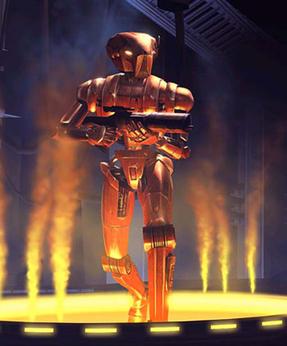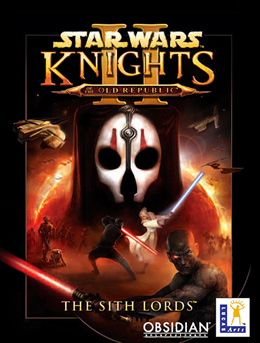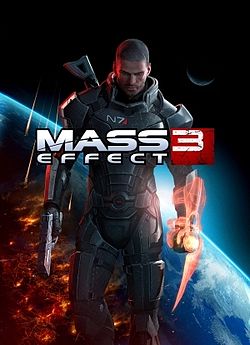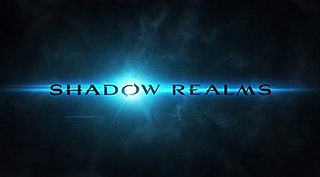
BioWare is a Canadian video game developer based in Edmonton, Alberta. It was founded in 1995 by newly graduated medical doctors Ray Muzyka, Greg Zeschuk and Augustine Yip, alongside Trent Oster, Brent Oster, and Marcel Zeschuk. Since 2007, the company has been owned by American publisher Electronic Arts.

Neverwinter Nights is a third-person role-playing video game developed by BioWare. Interplay Entertainment was originally set to publish the game, but financial difficulties led to it being taken over by Infogrames, who released the game under their Atari range of titles. It is the first installment in the Neverwinter Nights series and was released for Microsoft Windows on June 18, 2002. BioWare later released a Linux client in June 2003, requiring a purchased copy of the game to play. MacSoft released a Mac OS X port in August 2003.

Star Wars: Knights of the Old Republic is a role-playing video game developed by BioWare and published by LucasArts. The first installment of the Star Wars: Knights of the Old Republic series, it was released for the Xbox on July 16, 2003, and for Microsoft Windows on November 19, 2003. It was ported to Mac OS X, iOS, and Android by Aspyr, and it is playable on the Xbox 360, Xbox One, and Xbox Series X and Series S via backward compatibility. A Nintendo Switch version was released on November 11, 2021.

Beyond Good & Evil is a 2003 space opera action-adventure video game developed and published by Ubisoft for PlayStation 2, Windows, Xbox and GameCube. The story follows the adventures of Jade, an investigative reporter, martial artist, and spy hitwoman working with a resistance movement to reveal a sinister alien conspiracy. Players control Jade and other allies, solving puzzles, fighting enemies, obtaining photographic evidence and, later in the game, travelling to space.

Baldur's Gate II: Shadows of Amn is a role-playing video game developed by BioWare and published by Interplay Entertainment. It is the sequel to Baldur's Gate (1998) and was released for Microsoft Windows in September 2000. Like Baldur's Gate, the game takes place in the Forgotten Realms—a fantasy campaign setting—and is based on the Advanced Dungeons & Dragons 2nd edition rules. Powered by BioWare's Infinity Engine, Baldur's Gate II uses an isometric perspective and pausable real-time gameplay. The player controls a party of up to six characters, one of whom is the player-created protagonist, while the others are certain characters recruited from the game world.

HK-47 is a fictional droid in the Star Wars franchise. Introduced in the 2003 video game Star Wars: Knights of the Old Republic, he is an extremely efficient assassin droid constructed by Revan to assist them in hunting Jedi, until both have their memories wiped and made to serve the Jedi themselves. Voiced by Kristoffer Tabori, HK-47 reappears in the 2004 sequel, Star Wars Knights of the Old Republic II: The Sith Lords, the Trials of Obi-Wan 2005 expansion pack to the massively multiplayer online game Star Wars Galaxies, and the 2011 MMORPG Star Wars: The Old Republic, as well as various other novels, short stories, comics, and video games in the Star Wars Expanded Universe.

Star Wars Knights of the Old Republic II: The Sith Lords is a role-playing video game developed by Obsidian Entertainment and published by LucasArts. It is the sequel to BioWare's Star Wars: Knights of the Old Republic and was released for the Xbox on December 6, 2004, for Microsoft Windows on February 8, 2005, for OS X and Linux on July 21, 2015, for Android and iOS on December 18, 2020 and for Nintendo Switch on June 8, 2022. Like its predecessor, it is set in the Star Wars universe 4,000 years before the events of the film Episode I: The Phantom Menace and is based on the d20 System developed by Wizards of the Coast.

Dragon Age: Origins is a 2009 role-playing video game developed by BioWare and published by Electronic Arts. It is the first game in the Dragon Age franchise. Set in the fictional kingdom of Ferelden during a period of civil strife, the game puts the player in the role of a warrior, mage, or rogue coming from an elven, human, or dwarven background. The player character is recruited into the Grey Wardens, an ancient order that stands against monstrous forces known as "Darkspawn", and is tasked with defeating the Archdemon that commands them and ending their invasion. The game is played from a third-person perspective that can be shifted to a top-down perspective. Throughout the game, players encounter various companions, who play major roles in the game's plot and gameplay.

MDK2 is a 2000 third-person shooter, action-adventure video game developed by BioWare and published by Interplay Entertainment for the Dreamcast, Windows and PlayStation 2. It is a sequel to the 1997 game MDK. First released for the Dreamcast in March 2000, it was later released for Windows in May, with newly selectable difficulty levels and the ability to manually save. In March 2001, a slightly reworked version, featuring level design modifications and gameplay tweaks, was released for the PlayStation 2 as MDK 2: Armageddon. The PC version was released on GOG.com in September 2008, and on Steam in September 2009. A port of the PlayStation 2 version was released for Wii via WiiWare in 2011. Also in 2011, a HD remastered version was released for Windows. Called MDK2 HD, this version features new 3D models, textures, improved lighting, and remastered music, and was released on Beamdog in October, and on Steam in July 2012.

Raymond Alexander Muzyka is a Canadian investor, entrepreneur and physician. Originally trained as a medical doctor and practicing as an emergency department and family physician after graduation, he is the co-founder of video game developer BioWare, and was CEO, senior vice president, and general manager of the BioWare label of Electronic Arts. In October 2012 he announced that he was embarking on a 'third career' mentoring and angel investing in technology, new media, medical and social entrepreneurs, and impact investing at ThresholdImpact.

Gregory Zeschuk is a Canadian businessman who was a VP at Electronic Arts and General Manager at BioWare Austin until 2012. He co-founded video game developer BioWare in Edmonton in 1995 with Ray Muzyka and Augustine Yip, after all three earned their medical degrees from the University of Alberta. Zeschuk announced his retirement from BioWare on September 18, 2012. He is currently involved in a number of projects related to the craft-beer industry, including the production of a web-based interview show known as "The Beer Diaries." Greg is also the chairman of the board of the smart playground technology startup, Biba Ventures based in Vancouver, BC.

Mass Effect is an action role-playing game developed by BioWare and published by Microsoft Game Studios, originally released for the Xbox 360 in November 2007. It is the first game in the Mass Effect series, and takes place within the Milky Way galaxy in the year 2183, where civilization is threatened by a highly advanced machine race known as the Reapers. The player assumes the role of Commander Shepard, an elite human soldier who must stop a rogue agent from carrying out the Reapers' galactic invasion. The game involves completing multiple quests that generally involve space exploration, squad and vehicular combat, and interaction with non-player characters.
James Ohlen is a video game designer. He was Senior Creative Director of BioWare where he worked for 22 years prior to starting the publishing company Arcanum Worlds in 2018. In 2019, Ohlen became the lead of a new internal development studio Archetype Entertainment under Wizards of the Coast to develop new intellectual property and video games for the company.

Star Wars: Knights of the Old Republic (KOTOR) is a media franchise of space western role-playing video games created and developed by BioWare, which have seen releases on the original Xbox, Xbox 360, Microsoft Windows, OS X, Xbox One, Xbox Series X/S, IOS and Android. The franchise takes place in the fictional universe of Star Wars by George Lucas.

Mass Effect 2 is an action role-playing video game developed by BioWare and published by Microsoft Game Studios and Electronic Arts for Microsoft Windows and Xbox 360 in 2010 and published by Electronic Arts for PlayStation 3 in 2011. It is the second installment in the Mass Effect series and a sequel to the original Mass Effect. The game takes place within the Milky Way galaxy during the 22nd century, where humanity is threatened by an insectoid alien race known as the Collectors. The player assumes the role of Commander Shepard, an elite human soldier who must assemble and gain the loyalty of a diverse team to stop the Collectors in a suicide mission. Using a completed saved game of its predecessor, the player can impact the game's story in numerous ways.

Mass Effect 3 is a 2012 action role-playing video game developed by BioWare and published by Electronic Arts. The third major entry in the Mass Effect series and the final installment of the original trilogy, it was released in March 2012 for Microsoft Windows, Xbox 360, and PlayStation 3. A Wii U version of the game, entitled Mass Effect 3: Special Edition, was later released in November 2012. The game is set within the Milky Way galaxy in 2186, where galactic civilization is invaded by a highly advanced machine race of synthetic-organic starships known as Reapers. It concludes the story of Commander Shepard, an elite human soldier who is tasked with forging alliances between species for the war. It was the first title in Mass Effect series without involvement by Microsoft Game Studios.
Mass Effect is a military science fiction media franchise created by Casey Hudson. The franchise depicts a distant future where humanity and several alien civilizations have colonized the galaxy using technology left behind by advanced precursor civilizations.

Shadow Realms is a cancelled action role-playing video game previously under development by BioWare's Austin studio. The game was set to be published by Electronic Arts for Microsoft Windows, and was scheduled for release in 2015. On February 9, 2015, BioWare Austin announced that the development on Shadow Realms would not continue.

Mass Effect Legendary Edition is a compilation of the video games in the Mass Effect trilogy: Mass Effect (2007), Mass Effect 2 (2010), and Mass Effect 3 (2012). It was developed by BioWare and published by Electronic Arts. All three games were remastered, with visual enhancements, technical improvements, and gameplay adjustments. Mass Effect, the first game of the trilogy, received more extensive upgrades than its counterparts, specifically with regard to graphics, combat mechanics, vehicle handling, and loading times.


















